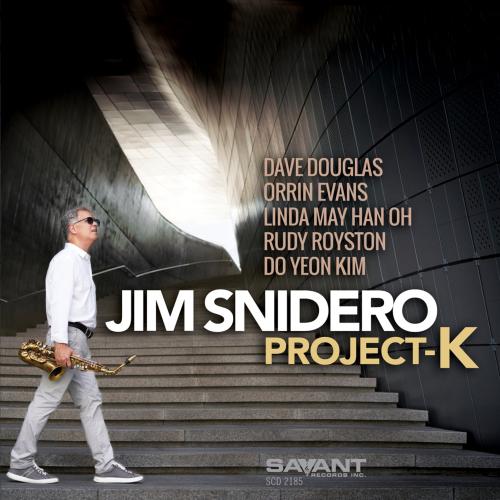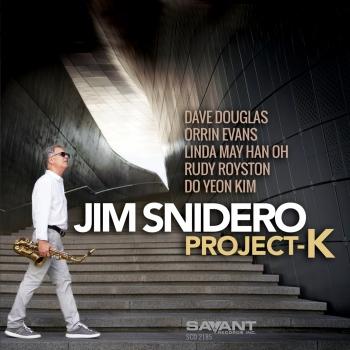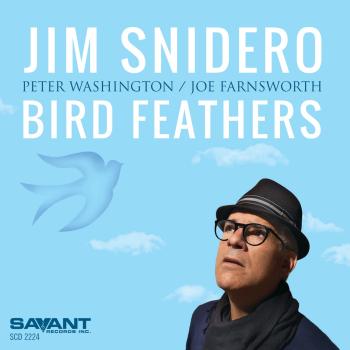
Project-K Jim Snidero
Album info
Album-Release:
2020
HRA-Release:
24.01.2020
Album including Album cover Booklet (PDF)
- 1 Han 07:46
- 2 DMZ 06:50
- 3 Jeju 06:49
- 4 Mother 05:57
- 5 Jenga 05:41
- 6 Seoulful 06:44
- 7 Goofy 07:10
- 8 Han O Bak Nyun 06:30
Info for Project-K
Over the course of the past four decades, and the 20-plus albums produced under his name, Jim Snidero has carved out his rightful place in the pantheon of the music. The esteemed alto saxophonist’s explorations have proved boundless, moving from downhome atmospheres to broad reflections on the American experience, refined string settings to probing realms, and nods to totemic figures to cathartic statements addressing personal loss. Having additionally worked with everybody from Brother Jack McDuff to Toshiko Akiyoshi to Frank Sinatra, established himself as a game-changing author, and taken his music and messages to concert halls, clubs and classrooms across the globe, it might be tempting to say that Snidero has done it all. But once again, he obliterates that assertion.
With Project-K, Jim Snidero breaks new ground. Absorbing and refracting varied aspects of Korean folkways, he delves into a topic near and dear to his home and heart. “Having a Korean wife, family, and friends, I’ve been immersed in Korean culture for more than 20 years,” he shares. “Between Korean history, culture and philosophy, I felt that there was much to explore musically.” Bridging his own wide-ranging aesthetic with those very traditions, Snidero turns out one of the most distinctive dates of his career.
In choosing the personnel to flesh out this music, Snidero’s decisions proved shrewd and sound. The rhythm section, comprised of pianist Orrin Evans, bassist Linda May Han Oh, and drummer Rudy Royston, brings a rare balance of sensitivity, strength, and insight to these ventures. And trumpeter Dave Douglas serves as the perfect front line foil for the saxophonist.
Connections abound across that group of five—Evans was a notable presence on Snidero’s Waves of Calm; Oh and Royston, both part of Douglas’ beloved quintet, were key figures on Snidero’s Stream of Consciousness and Main Street—but the sixth member of the band, who proves to be the x-factor, is new to Snidero’s world. Stepping outside the box, he brought in Do Yeon Kim, a virtuoso on the zither-like gayageum. “I wanted to use a traditional Korean instrument on Project-K and the gayageum appealed to me the most. My goal was to not simply feature the instrument as a separate entity,” Snidero explains, “but to have it fully integrated within at least some of the arrangements. Do Yeon was the first gayageum player accepted into the New England Conservatory, so she was the obvious choice.”
Together, these six honor Korea’s rich heritage while expanding musical worldviews. That’s clear from the first, as the sound of the Korean prayer bowl, traditionally used in Buddhist meditation, offers a welcome ring on “Han.” The first of six Snidero originals on the album, it’s a statement that speaks in both mournful and resilient tones. “Koreans have endured great hardship through their history, which has contributed to a uniquely Korean feeling called ‘Han.’ Difficult to describe, and very personal, Han could be thought of as a sense of deep sorrow and incompleteness tempered by endurance and acceptance,” he notes.
That opener, like the feeling it describes, proves incredibly nuanced in its expression(s). But what follows—the feisty “DMZ”—is something else entirely. “Do Yeon’s introduction to this piece perfectly projects what has been described as ‘the scariest place on Earth’—the Korean Demilitarized Zone. The piece has many harmonic conflicts, at one point with three keys being played and including the folk song ‘Arirang’ on the gayageum. The band builds a huge amount of intensity until the final, tensely quiet cluster.”
While the band’s signature sound is set by this point, moods and subjects continue to shift. “Jeju,” a pensive and peaceful journey, beautifully reflects the nature of the South Korean island lending its name to the music, while “Mother”—“a tribute to the artistic creativity of Koreans” that references Bong Joon-Ho’s 2009 film of the same name—brings angularity and reduced gravity into the picture (along with a larger role for the aforementioned Korean prayer bowl).
The jaunty “Jenga”—a K-pop cover recast in 3/4—offers some traded wonders while merging genres. The witty “Seoulful” plays on volleying intentions. And “Goofy” brings the blues and a swinging sensibility to the foreground. Then it all comes to a close with “Han O Bak Nyun,” a traditional folk song enriched by Snidero’s spiritual search and wrapped up by one last bowl ring.
Working together as a single entity, these musicians capture and illuminate Snidero’s vision with incredible focus and sincerity. “Dave, Orrin, Linda, Rudy, and Do Yeon were the perfect choices for Project-K,” relates Snidero. “Individually they are musicians of the highest order. As a group, we were all able to create what I believe is both unique and inspired music.”
Jim Snidero, alto saxophone
Dave Douglas, trumpet
Orrin Evans, piano
Linda May Han Oh, bass
Rudy Royston, drums
Do Yeon Kim, gayageum (zither)
Jim Snidero
Over the past thirty-five years, Jim Snidero has come to be known as one of the finest jazz musicians of his generation. As an alto saxophonist, composer, arranger, author and educator, Snidero has been called both a “master musician” and “alto saxophone virtuoso” by Downbeat Magazine, and placed in the 2017 Downbeat Critic’s Poll, demonstrating his continued impact on the international jazz scene.
Jim Snidero grew up in Camp Springs, Maryland, just outside of Washington, DC . Musically nurtured from a young age, both at home and in his school music program, Snidero began to quickly show promise as a musician. As a teenager, Snidero studied with the great Phil Woods and was a member of the famed One O’Clock Lab Band at the world-renowned jazz program at the University of North Texas. Studies with another saxophone great—Dave Liebman—helped Snidero to reach the next level as a musician and, ultimately, helped him to make the decision to move to New York at the conclusion of his college years.
After arriving in The Big Apple in 1981 at age 23, Snidero first appeared on the jazz radar when he joined Brother Jack McDuff’s band, recording 3 albums with a jazz giant. That proved to be the first of many notable sideman stints for the then-budding saxophonist. Word of his skills quickly spread, leading Snidero down other avenues with the Mingus Big Band, saxophone icon Frank Wess, the Toshiko Akiyoshi Jazz Orchestra, Eddie Palmieri, and Frank Sinatra (Duets II, Capitol), to name just a few.
Snidero became a leader on record with On Time (Toshiba/EMI 1984), the first of many notable dates that he would record under his own name. Over the quarter century that followed, he created an enviable body of work built with musical consistency and stylistic diversity. Highlights include Mixed Bag (Criss Cross, 1987), his first widely-available release, Blue Afternoon (Criss Cross, 1989), deemed one of the best jazz records in history in The Penguin Jazz Guide: The History Of The Music In The 1001 Best Albums, and Strings (Milestone, 2003) which he both composed and arranged for string orchestra, hailed a “masterpiece” by several major news organizations.
The last ten years has delivered a series of well-received dates for the prominent Savant record label. Snidero initially focused on a guitar-centric line-up, among other things teaming up with young modernists like bassist Linda Oh and drummer Rudy Royston for dazzling efforts like Stream Of Consciousness (Savant, 2013), resulting in Snidero placing in Downbeat Magazine’s 2014 Reader’s poll. He then pivoted to piano trio with Main Street (Savant, 2015) and quintet with MD66 (Savant, 2016) inspired by Miles’ Davis’ second great quintet, resulting in a critic’s pick in Jazz Times magazine.
In 1996, Jim Snidero revolutionized jazz education by penning the first Jazz Conception books. These best-selling books eventually spawned an Easy and Intermediate series that filled in the gaps for players at different levels; to date, the Jazz Conception series contains over forty books, and it remains an incredibly popular jazz education resource. In 2013, Snidero furthered his role as a jazz education visionary, creating The Jazz Conception Company, which explores a new frontier in the technology-meets-education world.
Jim Snidero is an adjunct faculty member at The New School in New York and New Jersey City University, and he’s been a visiting professor at some of the finest music institutions in the world, including Indiana University and Princeton University. In addition, Snidero endorses Selmer saxophones and D’Addario reeds.
Booklet for Project-K













